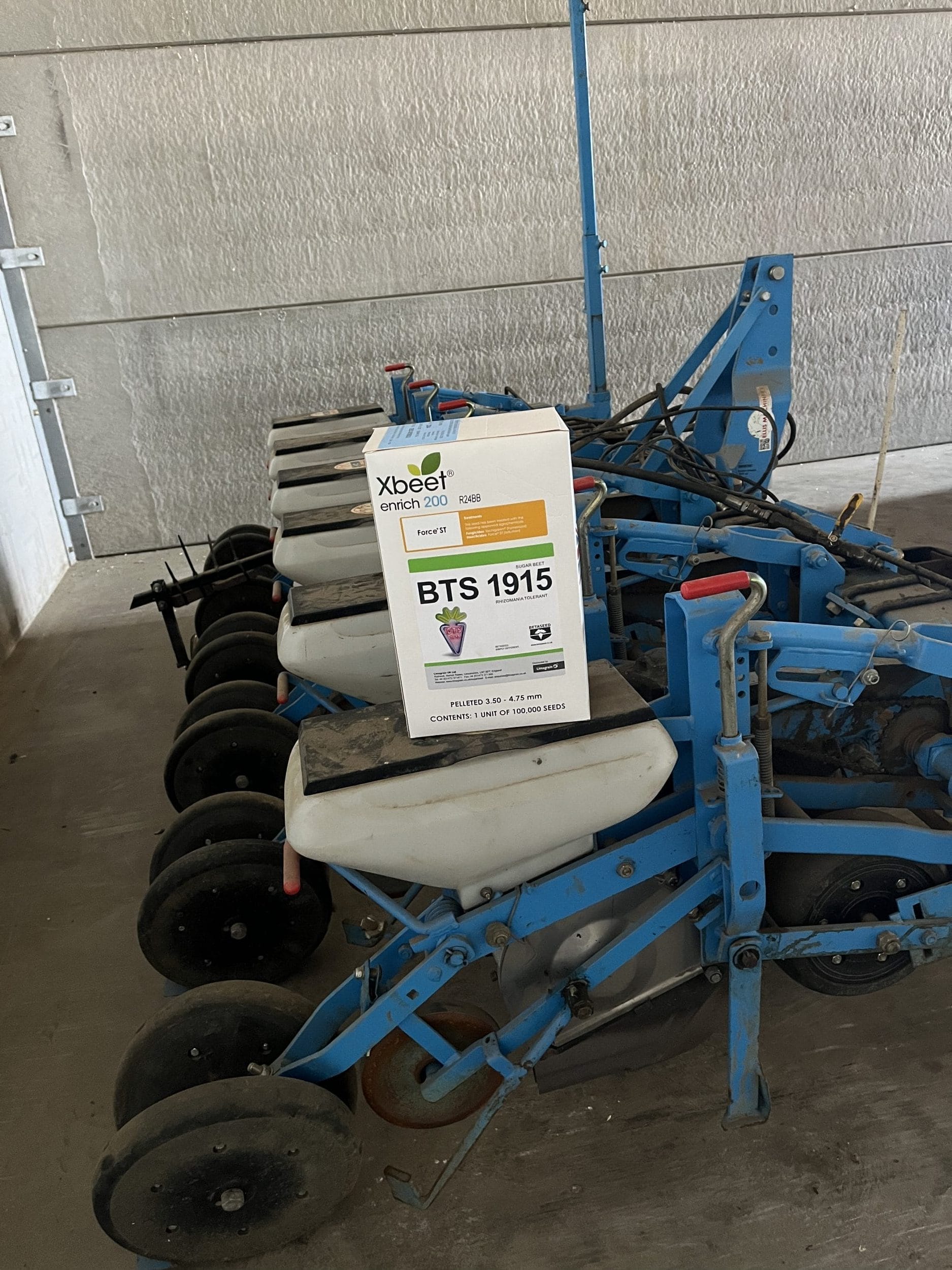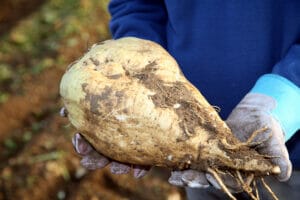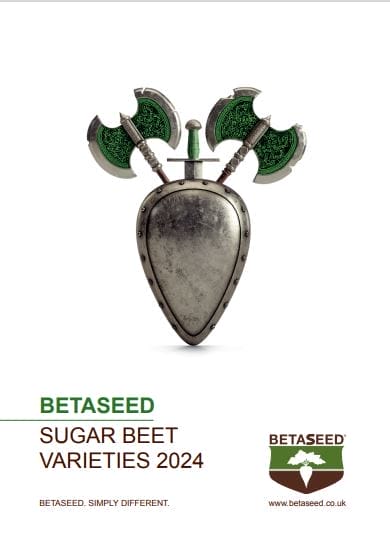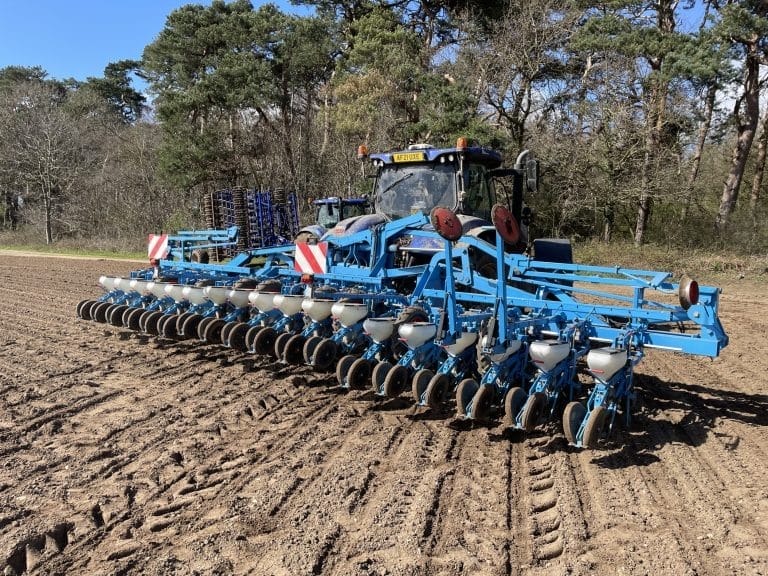
Sugar beet plays an important part in the rotation because it provides consistent yields and is a genuine break crop, according to fourth generation farmer Peter Mahony, of R&D Mahony.
“We grow sugar beet because it is a spring-sown crop that contributes to weed control, particularly black grass, which can be problematic as our soils are mainly heavy clay which predisposes them to the weed.”
Mr Mahony’s variety of choice over the past three years has been BTS 1915, which he likes because it ‘ticks the box on consistent yield’. He has also grown BTS 1140 and BTS 3610.
“BTS 1915 fits well with our system despite the variety being susceptible to bolting, as we are growing the crop in heavy soils, so we do not usually drill until the second half of March.”
The Bury St Edmunds-based farm has been growing sugar beet since the mid-1960s, so there is plenty of crop management experience behind decisions, although Peter emphasises that every spring brings different challenges.
Sugar beet usually follows winter wheat and Peter’s strategy is to plough in the autumn, burn off volunteers with glyphosate, repeat this again in the spring and create a nice seedbed with good tilth.
His five-year average yield is 73t/ha, he reveals, remarking that this is a good result given the heavy soils the crop is grown in. However, last year, yields were lower due to the drought and beet moth issues.
 “Whilst we have a had a few dry springs, this year we are also coping with March and April being unreasonably cold and very wet.
“Whilst we have a had a few dry springs, this year we are also coping with March and April being unreasonably cold and very wet.
“But we have to work with what we are given, and beet drilling was split with 7ha drilled on the 5th April and the remainder 18-19th April.
“We planted into very wet seedbeds, so we kept drilling depths shallow to conserve the tilth on the top.”
By the third week of May the crops were at the four to eight-leaf stage, and looking very healthy.
Peter goes on to share some of his ‘secrets’ of how he addresses some of the inherent challenges to get the most from sugar beet crops on his land.
“We find that quite often it can be too hot in the day to apply herbicides, so we prefer to go in the evening.
“If the machinery has been used for spraying cereals, we make sure it is given a good clean before it goes into sugar beet to prevent contamination.”
He has also adjusted his fertiliser strategy for sugar beet, to ensure the best results.
“When the crop emerges we like to apply 80kg/N/ha to give it a good push. However, although we use liquid N on the other crops in the rotation, it can cause scorch on sugar beet and also interfere with herbicide efficacy.
“As a result, we buy solid fertiliser especially for the sugar beet, which, as it is bought in small quantities, is expensive, but the end result is worth it.”
Lifting sugar beet can cause soil compaction which needs remedial work before the next crop goes in and Peter points out that the harvester, which weighs 40t, plus the tractor and trailer are all on the field at the wrong time of year.
“We normally try to have just two or three lifts, and then go into spring barley.”
“However, last year we managed to lift in mid-October, which worked well.”
One of the reasons behind this early lifting was because there was an attack of beet moth; last year also saw challenges from heat, drought and aphids.
“With BTS varieties, and particularly BTS 1915, we are able to achieve consistent yields. This means we know what we are going to get, even when prices are not so good.
“However, as we are now changing our tillage strategy, and will be using a Claydon drill, we will have to evaluate where – and whether – sugar beet will sit with the new regime.”
Farm facts:
Home farm: 133ha (330 acres)
Contract farm: 81ha (200 acres)
Soil: Heavy clay
Current rotation: Winter barley, winter wheat, beans, sugar beet, spring barley
Highest yields for third year running
The highest yielding variety on the Recommended List, BTS 1915 keeps its lead for the third year running at 103.9%.
“BTS 1915 is once again showing its ability to hold onto its exceptional yields across a range of locations and situations.”
“The consistency of performance of BTS 1915 is quite remarkable, and should give growers the reassurance that they are looking for when considering what variety to grow this year.”
“This significant yield advantage over any other variety on the RL – and also as the highest yielding variety in untreated trials at 106.5%, really proves the quality of the genetics behind the variety,” says Mr Granger.
BTS 1915 is not just about high yields however, he continues. “We recognise that varieties also need to establish well, have good bolting tolerance and robust disease resistance to succeed.”
BTS 1915 does have a good disease resistance profile but is not a variety to be considered for the early drilling situation as indicated by the red X (unsuitable for sowing before mid March), points out Mr Granger.
“We recommend the variety for the normal to late sowing period – mid March onwards, which for the majority of growers is the mean average drilling date on farm. ”
BTS 1915 Facts
• Bred by Betaseed, the Limagrain UK portfolio offers varieties to suit a range of situations and requirements:
• BTS 1915 – The highest yielding variety available
• Suitable for sowing Mid March onwards
• Good disease resistance



































